В данной статье мы с вами будем рассматривать синий экран смерти, который именуется PROCESS1_INITIALIZATION_FAILED и имеет номер 0x0000006B. Что сами Майкрософт говорят по поводу этой проблемы? Они говорят вот что: «Данная проблема появляется вследствие повреждения файла Bootcat.cache или же из-за изменения размера этого файла». Из этого мы точно можем утверждать, что проблема заключается в файле Bootcat.cache. Также нельзя исключать таких вещей, как повреждения системных файлов, аппаратных компонентов, кабелей или прочее. Синий экран смерти PROCESS1_INITIALIZATION_FAILED может проявлять себя на большинстве версий операционной системы Windows.
В сообщении этого критического сбоя присутствует следующая информация:
STOP: 0x0000006B (Параметр1, Параметр2, Параметр3, Параметр4)
PROCESS1_INITIALIZATION_FAILED
Заметка: эти четыре параметра могут меняться в зависимости от конфигурации компьютера пользователя.
Помимо прочего, этот синий экран смерти можно увидеть даже на клиентах, серверных машинах и смартфонах. В данной статье мы опишем целых 8 методов, которые помогут разрешить вам эту непростую ситуацию.
Решаем сбой PROCESS1_INITIALIZATION_FAILED
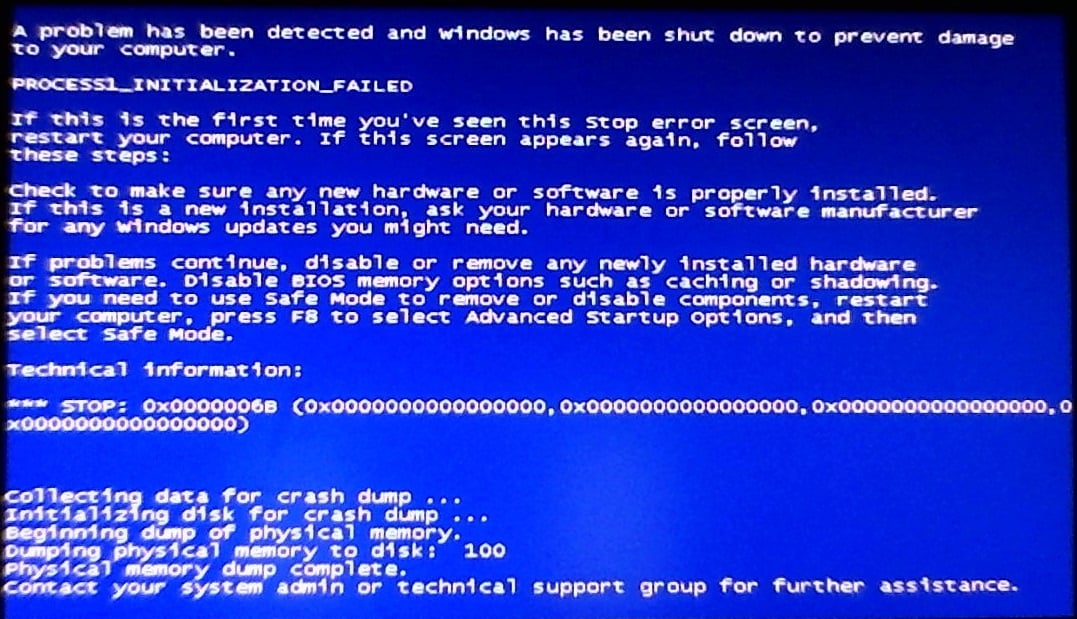
Метод №1 Удаление файла Bootcat.cache
Следуя из сообщения Майкрософт, первым вашим шагом станет удаление файла Bootcat.cache из папки CodeIntegrity. Данный файл располагается в директории C:\Windows\System32\Codeintegrity. Вам понадобится загрузить компьютер через диск восстановления системы Windows. Если вы не знаете, как создать этот диск, то пройдите по этой ссылке на сайт Майкрософт, где написаны точные инструкции по его созданию. Создав этот диск, сделайте следующее:
- Вставьте диск или же флеш-носитель в свой компьютер.
- Перезапустите компьютер.
- Загрузите систему через диск восстановления Windows.
- Выберите предпочитаемый язык и другие параметры, а затем нажмите «Далее» для продолжения.
- Кликните на кнопку «Восстановление системы».
- Далее пройдите путем «Диагностика→Дополнительные параметры→Командная строка»
- Выберите пункт «Командная строка».
- Впишите в нее команду diskpart.
- Впишите list volume и нажмите Enter.
- Запомните в каком разделе находится ваша ОС, затем впишите Exit и нажмите Enter.
- Впишите C:(укажите тот раздел, в котором находится ваша ОС) и нажмите Enter.
- Впишите cd windows\system32\codeintegrity и нажмите Enter.
- Впишите del bootcat.cache и нажмите Enter.
- Закройте Командную строку.
- Перезагрузите свой компьютер, а затем попытайтесь зайти в систему обычным путем.
Метод №2 Копирование Bootcat.cache с другого компьютера
Если первый метод вам не помог в решении проблемы с синим экраном смерти PROCESS1_INITIALIZATION_FAILED, то вы должны попробовать этот метод, который включает в себя копирование файла Bootcat.cache с другого компьютера, подразумевая, что тот работает там корректно. Также как и в предыдущем методе, вам снова придется загрузить свою систему через диск восстановления.
- Найдите другой компьютер и зайдите в его операционную систему.
- Вставьте в флеш-устройство в компьютер.
- Нажмите Windows+E чтобы открыть Проводник Windows.
- Пройдите в директорию C:\Windows\System32\Codeintegrity.
- Копируйте файл Bootcat.cache к себе на флеш-устройство.
- Вставьте флеш-хранилище в компьютер, у которого проблемы с синим экраном смерти PROCESS1_INITIALIZATION_FAILED.
- Запустите проблемный компьютер через диск восстановления Windows и доберитесь до Командной строки, как это было показано в предыдущем методе.
- Открыв Командную строку, впишите в нее команду diskpart.
- Впишите list volume и нажмите Enter.
- Запомните в каком разделе находится ваша ОС, затем впишите Exit и нажмите Enter.
- Впишите C:(укажите тот раздел, в котором находится ваша ОС) и нажмите Enter.
- Впишите cd windows\system32\codeintegrity и нажмите Enter.
- Впишите copy E:\bootcat.cache(впишите ту букву, под которой выступает ваше флеш-хранилище) и нажмите Enter.
- Закройте Командную строку.
- Перезагрузите свой компьютер.
Метод №3 Удаление файла COMPONENTS
Итак, если ничего из вышеперечисленного не помогло, а такое вполне возможно, то давайте двигаться дальше. На этот раз мы с вами попробуем сделать кое-что другое — удаление файла COMPONENTS из директории windows\system32\config. Данное действие также зарекомендовало себя отличным способом по борьбе с синим экраном смерти PROCESS1_INITIALIZATION_FAILED.
- Снова запустите свою ОС через диск восстановления.
- Пройдите весь путь до Командной строки, как это было уже показано в предыдущих методах.
- Впишите команду diskpart и нажмите Enter.
- Впишите list volume и нажмите Enter.
- Впишите Exit и нажмите Enter.
- Впишите cd windows\system32\config и нажмите Enter.
- Впишите del components и нажмите Enter.
- Закройте Командную строку.
- Перезагрузите свой компьютер.
Ну что, ваша система все еще загружается с синим экраном смерти PROCESS1_INITIALIZATION_FAILED? Ок, тогда давайте двигаться далее.
Метод No4 Установка Windows 7 SP1
Если вы используете Windows 7 без SP1, то вам нужно попробовать установить этот сервисный пакет для вашей операционной системы. Все что вам нужно сделать, так это пройти в Центр загрузок Майкрософт и скачать от туда необходимый сервисный пакет. Однако, будьте внимательно, что именно вы скачивайте. Обязательно отталкивайтесь от того, какой разрядностью обладает ваша система, т.е. 32-битная или 64-битная. Загрузите Windows 7 SP1, установите его и перезагрузите систему. Затем проверьте, появляется ли синий экран смерти PROCESS1_INITIALIZATION_FAILED.
Метод No5 Удаление Roxio GoBack
Если вы используете программное обеспечение Roxio GoBack, то вам нужно попробовать удалить его, чтобы проверить, не вызывает ли ли оно уже оговоренный синий экран смерти. Удаляется Roxio GoBack довольно просто через Программы и компоненты.
- Нажмите на клавиатуре Windows+R.
- Впишите appwiz.cpl и нажмите Enter.
- Выберите Roxio GoBack и удалите ее.
- Перезагрузите компьютер.
- Протестируйте систему на стабильность.
Возможно, что именно эта утилита и стояла за таким серьезным сбоем в системе, как PROCESS1_INITIALIZATION_FAILED. Однако, если ничего не изменилось, то давайте двигаться дальше по нашему списку методов.
Метод №6 Восстановление Windows с помощью утилиты DISM
Для выполнения этого метода, нам потребуется использовать утилиту под названием DISM. DISM — это команда, которая позволяет вам монтировать образ Windows(install.wim) и выполнять такие действия, как установку, удаление, настройку и обновление операционной системы. DISM является компонентом комплекта средств для развертывания и оценки Windows(Windows ADK), который можно загрузить по этой ссылке. Итак, чтобы восстановить Windows с помощью утилиты DISM, вам потребуется сделать следующее:
- Для начала загрузите Windows ADK, а затем установите DISM.
- Нажмите на Пуск и впишите в поисковик запрос «Система обслуживания образов развертывания и управления ими».
- Нажмите на найденный результат ПКМ и выберите Запустить от Администратора.
- Впишите в нее DISM /image:D:\ /cleanup-image /revertpendingactions и нажмите Enter.
- После выполнения команды, перезагрузите свой компьютер, а затем протестируйте систему на наличие синего экрана смерти PROCESS1_INITIALIZATION_FAILED.
Метод №7 Исключить папку от сканирований
Антивирусное программное обеспечение также может стоять у истоков проблемы с появлением оговоренного синего экрана смерти. Чтобы исправить это, вам нужно исключить папки CodeIntegrity и catroot от сканирования антивирусом. Сейчас мы покажем вам как это делать на примере Защитника Windows. Если вы используете иной антивирус, то это не беда, так как там, скорее всего, будут применимы эти шаги.
- Кликните на Пуск и впишите в поисковик запрос «Защитник Windows».
- Нажмите на найденный результат ПКМ и выберите «Запустить от имени Администратора».
- Перейдите во вкладку «Параметры».
- Кликните на «Добавить исключение».
- Кликните на «Исключить папку».
- Пройдите в директорию C:\Windows\System32\CodeIntegrity.
- Кликните «Исключить эту папку».
- Кликните на «Исключить папку» еще один раз.
- Пройдите в директорию C:\Windows\System32\catroot.
- Кликните «Исключить эту папку».
- Еще раз хорошенько проверьте, исключили ли вы нужные вам папки.
Возможно, синий экран смерти PROCESS1_INITIALIZATION_FAILED появлялся в случае сканирования этих папок. По крайней мере, так утверждают некоторые пользователи в Интернете. Ну что, проблема все еще преследует вас?
Метод №8 Использование утилиты CHKDSK
Когда ваш жесткий диск не работает как надо, то на нем могут появиться поврежденные данные или же плохие сектора. В этом случае вам поможет довольно неплохая системная утилита CHKDSK, которая поможет найти вам бэдблоки и исправить их, но только если это будет возможно.
- Нажмите ПКМ на Пуск и выберите «Командная строка(администратор)».
- Впишите chkdsk /r и нажмите Enter.
- Далее напишите Y и нажмите Enter, чтобы принять перезагрузку компьютера.
- Подождите, пока утилита завершит починку файловой системы на компьютере. Должны завершиться все пять стадий операции.
Мы надеемся, что данная статья помогла вам преодолеть проблему в виде синего экрана смерти PROCESS1_INITIALIZATION_FAILED. Если же он так и продолжает постоянно проявляться, то вы также можете еще попробовать выполнить восстановление системы с помощью ранее созданной точки или через бэкап. Если и это не помогло, то это может означать, что у вас присутствуют проблемы аппаратного характера, например, виновниками могли стать ваш HDD/SSD или же оперативная память.
Blue Screen error is completely destructive to the windows 10 system and almost irrecoverable in most cases. PROCESS1_INITIALIZATION_FAILED is one such issue that appears and leads the computer to start bug checking. Just after that Windows 10 restart and then again repeat the same process. Bug check value for this BSOD is 0x0000006B. The problem occurs mainly due to corrupted Bootcat.cache file or often when this file is resized at the time of booting.
The initial problem you may encounter after being affected by stop error PROCESS1_INITIALIZATION_FAILED is a frequent restart and bug checking. There might be irregular flashing on the screen and freezing of the desktop area temporarily. Things will get complicated much when the Windows will start rebooting frequently leaving no option to take any action. You know well stop error or BSOD is a critical system crash leading the system resources to go missing. However, Microsoft indicated Bootcat.cache file related issues are the main reason behind this BSOD error, you have got more common causes. Driver problems mostly outdated ones, missing dll files; bad areas in hard disk, using an old edition of OS can also cause the same issue. Before the error causes much noxiousness in your Windows 10 system, let’s resolve it from today’s discussion. Starting with the Method list –
PROCESS1_INITIALIZATION_FAILED
Here is how to fix PROCESS1_INITIALIZATION_FAILED BSOD error in Windows 10 –
1] Disable Automatic Restarting feature
PROCESS1_INITIALIZATION_FAILED blue screen error forces Windows to a very critical system crash. Necessary resources tend to go missing and the Windows shuts down immediately in order to minimize the extent of the loss. Therefore, the error message will appear on display with bug code 0x0000006B and you cannot take any action to save an ongoing task. The entire system will be unstable and definitely, no can detect the cause of the issue as well as apply fix accordingly.
Automatic Restarting is a built-in feature in Windows computer and it can be disabled tweaking Startup settings. Once disabled, you can approach for deploying the workarounds and get fixed BSOD error. Here is how to disable the feature –
- Click on Start, type System properties and then press Enter.
- Select “System info” from the right pane.
- Choose Advanced system settings from the left column of the next Window.
- When the System Properties will open, jump into the Advanced tab.
- On the Startup and Recovery area, perform a hit on the Settings button.
- In the next pop up, move out for the System failure field.
- Uncheck the box that is set for “Automatically restart”.
- Finally, click the OK button at the bottom and save these changes.
2] Delete the Bootcat.Cache to fix PROCESS1_INITIALIZATION_FAILED BSOD
Windows 10 encounters PROCESS1_INITIALIZATION_FAILED BSOD once the Bootcat.Cache file becomes corrupted or resized at the startup. This is a component of CodeIntegrity and its location in Windows is “C:\Windows\System32\Codeintegrity”. In order to fix the drawback, we have to delete this file and boot the system to fully functional OS.
Here are the steps you have to follow –
- Press Windows logo key and I.
- Click Update & Security.
- From the next page, select Recovery located at the left pane.
- Move on to adjacent right side pane and reach to Advanced startup.
- Click Restart now.
- When the blue screen shows up next, choose to Troubleshoot => Advanced options => Command Prompt.
- In the Elevated Command Prompt window, insert below text –
C:
cd windows/system32/codeintegrity
del bootcat.cache
- Press Enter.
- Once deleting is done, exit Command Prompt and Restart Windows 10.
- The system will recreate the Bootcat.cache file again automatically and PROCESS1_INITIALIZATION_FAILED error will be fixed.
See if you need – Fix: bootrec /fixboot access denied in Windows 10.
3] Copy Bootcat.cache files from another computer
In case deleting the Bootcat.cache file from your computer doesn’t resolve the PROCESS1_INITIALIZATION_FAILED BSOD error, you can apply another hotfix. The idea is to copy this file from a full function and error-free computer running the identical version of Windows 10.
- Copy C:\Windows\System32\Codeintegrity, Press WIN+R, and paste the same.
- Hit Enter.
- Copy all the items from this location and place in a USB drive by pasting.
- Insert the device through a port in the system getting the error and copy all the items in the same location.
4] Disable Secure Boot
Secure Boot in Windows 10 keeps the system protected from virus attack and this is another advanced technology support working on top of the Unified Extensible Firmware Interface (UEFI). The utility is intended for ensuring the computer boot up using only trusted firmware supplied by the manufacturer.
Some users have come up with a fact that having Secured Boot enabled in Windows 10 can be dangerous as it often causes PROCESS1_INITIALIZATION_FAILED BSOD error. Usually, that might happen due to some hardware misconfiguration and in that case, you have to disable it. The guidelines are as following –
- Boot Windows 10 to Automatic Repair using guidelines from the 2nd method above.
- When the blue screen floats up, select Troubleshoot > Advanced Options.
- From the next screen, select UEFI Firmware Settings to enter into BIOS.
- Though Every OEM has its own way of showing options, Secure Boot is usually residing under Security / Boot / Authentication Tab.
- Set the Secure Boot to Disabled.
- Press F10 in order to Save and Exit.
- Restart Windows and changes will be effective immediately.
5] Install the latest patches
Outdated Windows 10 is very much likely to be affected by PROCESS1_INITIALIZATION_FAILED BSOD error especially if a released package is left uninstalled for long time. The update patches released by Microsoft always come with something new, advanced technologies, security modification, and moreover the big fixes. You might have missed out some important change and end up encountering blue screen error.
Updating the latest patches in Windows 10 is one easy task and automatic when the device is connected with an active unmetered internet connection. But often the system is out to install automatically and you need to check for updates time and again manually. Here are the steps to install latest patches to update OS –
- Press Windows key to open the Start menu and click Gear icon from there.
- From the UI opening next, select the Update & Security tile.
- After additional setting page unrolls, select Windows Update from the left pane.
- Jump to the adjacent right side and click on Check for updates link.
- After all, patches being available, click Download button.
- Installation will begins automatically upon accomplishing the downloading.
- Attend Restarting as guided to complete the updating process successfully.
6] Run a full system scan for malware
Malware is strongly coded programs staying in disguise like a usual file in the system. As the computes nowadays are always connected to the internet, the chances to get affected by spyware are a lot more. These bugs are always on the move through links in webpages, spam mails, and often via USB drives too. Though the Primary intention of a virus is to steal sensitive data and cause harm to the owner, they are responsible for corrupt system files too. Some DLL files will also go missing leading the system to undergo PROCESS1_INITIALIZATION_FAILED BSOD error.
While surfing the internet, you need to be more cautious about worms, Trojans, spyware and must not click any suspicious links. Anti-virus programs keep the system secured by eliminating malware and strengthening the shield. Windows Security is the latest inclusion by Microsoft with robust architecture to provide maximum security to the system. A full system scan with this tool will help you stay out of malicious programs both online and offline. Here are the steps to run a full system scan in Windows Security –
- Open the Start menu and scroll down in the app list alphabetically.
- Click Windows Security to launch it.
- From the following window, select “Virus & threat protection” located at the left pane.
- Click on Scan options link from the right side pane.
- Choose the radio button set for Full scan and click Scan now button.
- If the tool detects some vulnerability, click Clean Threat option to get rid of them.
- On the following page, click Remove followed by clicking Start actions to clean up all the threats.
- When the process ends, Restart Windows 10 to make changes effective.
7] Copy and register ntdll.dll file
Not only Bootcat.cache file, missing some DLL files such as ntdll.dll is equally responsible for the PROCESS1_INITIALIZATION_FAILED BSOD. In order to fix the error, we can copy the same file from a secured computer and paste it to the System32 folder of affected computer.
The process is almost similar to copying the Bootcat.cache file as discussed before but you need to register after pasting it. The prerequisite is safe to use USB drive and the computer from which you will be copying must have the same edition of Windows 10. Follow the below instructions to accomplish the task –
- Insert the USB drive to the identical and healthy computer from where you choose to copy the DLL files.
- Go to C:\Windows\System32 and copy all the files having .dll extension.
- Paste the items to the USB drive.
- Take out the drive and insert to the affected computer.
- Copy and Paste all the .dll files to C:\Windows\System32.
- Now, launch the elevated Command Prompt and enter below commands –
regsvr32 (name of DLL file)
Note – Replace name of DLL file with ntdll.dll, wintrust.dll, vbscript.dll, oleaut32.dll, cryptdlg.dll, softpub.dll, jscript.dll, initpki.dll, msxml.dll successively.
- Press Enter key after each.
- Finally, Restart.
- Hopefully, the PROCESS1_INITIALIZATION_FAILED BSOD error will resolve once this change is effective.
8] Run Startup repair
Startup Repair is an advanced recovery tool in Windows that fixes issues restricting Windows 10 from starting at all. The tool will run a few diagnostics and try to fix the problem so that you can boot up Windows 10. PROCESS1_INITIALIZATION_FAILED BSOD leads the windows to a very critical system crash and that may affect the startup of it. Therefore, carrying out the repair might be a good option to fix the error and many users have got successful results.
The guidelines are as follows –
- Insert the Installation media drive like CD/DVD/USB to the Windows 10 computer.
- Restart the Windows and press any key while booting.
- Select Language Preference.
- Hit the Next button there.
- Do a click on Repair your Computer.
- Choose the OS edition that you opt to.
- Hit the Next button.
- Choose “Startup Repair” option from the next display. Now the system will carry out some scans and fix if the device has some booting related issues automatically.
- In order to check, click on the ‘View Diagnostic & Repair Details.’
- Hit the Finish button from here to restart Windows 10.
- Once it starts again, check if the PROCESS1_INITIALIZATION_FAILED BSOD error is fixed.
9] Run System File Checker
System files have fixed components and structure that make it executable when necessary to run the Windows. These files can be corrupted due to power surge, malware infection, and updating issues as well. Corrupted system file appears unreadable after losing the components and structure from them. The last result of this problem is PROCESS1_INITIALIZATION_FAILED Blue Screen error too.
You have the ability to solve these broken system files and recover some missing DLL components using System File Checker utility. Follow the below guidelines –
- Hold down Winkey and press R.
- In the empty text box of Run, type cmd.
- Press Ctrl+Shift+Enter keys together at once.
- Click Yes when UAC floats up to open Elevated Command Prompt.
- In the succeeding black window, type below command and press Enter –.
sfc /scannow
- Now, System File Checker will detect and resolve unsettled components and rectify them furthermore missing DLL files will be recovered accordingly.
- Once done, Restart Windows 10 and make all the changes effective.
10] Update the drivers to re-gain stability
Drivers provide stability in the system as well as maintain interaction between computer bus and the hardware accessories. They are key components and every function needs minimum one “driver” to perform its function and establish the relationship. When they remain outdated, the system will lose the integrity, functionality, and will be unstable as well. In order to make the system up and running, there is no alternative to updating these components. The easiest way to update all the drivers simultaneously is Windows upgrade but you often customize this setting as of saving time.
Most of the Blue Screen errors like PROCESS1_INITIALIZATION_FAILED are the upshot of Driver related issues. You may get such trouble occurs because of outdated or a defective update is installed in the system. Windows Device Manager is a complete utility to update the drivers and more driver related upper hands like Uninstalling and rolling back them to default. Moreover, you can easily detect and outdated one as they will be shown with identifying sign. Here are the steps to update a driver using Windows Device Manager –
- Invoke Run dialog and type devmgmt.msc in the text box.
- Click Ok button on the box to open up Windows Device Manager.
- When the console loads completely, look closely for any mark of exclamation.
- Split the driver list of that device by double-clicking.
- Make a right-click on the outdated driver having a yellow indication on it.
- Select Update Driver option from context.
- From the appearing popup, click “Search automatically for updated driver software” option.
- In the end, restart and make all these changes working.
11] Uninstall or disable third party anti-malware program
Anti-malware programs strengthen the security layer in a system and keep it protected from potential threats. We have told earlier how Windows Security maintains the utmost protection to Windows and of course, it’s a default tool. Using a third-party anti-virus application may often be a little unsafe as not all can be trustworthy. PROCESS1_INITIALIZATION_FAILED error might be a consequence of this reason.
Since Windows Security is the best ever utility to eliminate malware, you can rely on it completely. It is legit to uninstall all third party anti-malware programs to keep the system out of additional trouble. You can uninstall them using the below steps –
- Press Windows key and X and select Apps and Features option from the list.
- Move to the right pane, locate a third-party anti-malware program, and do a click on it.
- Hit Uninstall option from expanded pane.
- If any confirmation message shows up, click “Uninstall”.
- Follow the next guidelines to complete this task.
- Finally, restart Windows and check if the error appears again.
12] Perform System Restore and undo recent changes
Recent changes in Windows might have a contradiction with Windows Registry resulting in PROCESS1_INITIALIZATION_FAILED error. You often install new programs from various unknown sources where some of this may seem buggy. Forcibly canceling any task like uninstalling programs can also be risky to have negative changes in the system.
In order to fix the Blue Screen error evolved after any such changes; you can simply undo it by loading back previous state. One of the easiest ways to bypass any critical issues and process is System Restore. The tool will reverse Windows to an earlier saved Point of time in Windows 10 where you were not experiencing an error. To run the utility, follow the below guidelines –
- Press Windows key and type recovery in the text area.
- Select the same “Recovery” under Best match.
- When a new window opens from Control Panel, select Open System Restore link.
- From the wizard coming up, click Next from the bottom end.
- From the succeeding page, put a checkmark to the box says Show more restore points.
- After the system shows all the points, choose the most recent where you prefer to revert Windows.
- Select Next to proceed ahead.
- After the following page unrolls, click the Finish button.
- Click Yes from the warning message popup to continue restoring.
13] Repair Windows image file using DISM tool
Windows image file can cause PROCESS1_INITIALIZATION_FAILED BSOD error got corrupted. These are the components of a major upgrade of Windows that come in ISO- format. The usual task with these snapshots is to make identical CD-R or DVD-R drive for upgrading Windows.
The installation image, after getting corrupted by third-party tools, malware attacks, causes BSOD or blue screen error in Windows 10. Running Deployment Image Servicing and Management tool is the best way to fix the defective image files. Here are the instructions to run this tool –
- Open the Start menu pressing Windows key once.
- Click Power icon and select Restart option keep holding Shift button down at the same time.
- Window, after completing Rebooting, will boot to Automatic Repair.
- From the subsequent blue screen, select Troubleshoot > Advanced options > Command Prompt.
- When the black screen will show up, type following command at blinking cursor –.
DISM /Online /Cleanup-Image /RestoreHealth
- Press the Enter key to activate DISM tool.
- Upon finishing the task, Restart the computer.
- Check if the BSOD error has resolved already.
14] Try booting Windows 10 in Safe Mode
Booting in the Safe Mode is a startup method allowing the least number of programs and tools to be loaded for running the system. The target is to cut off third-party applications and unnecessary programs so that system runs with minimum resources. This will make troubleshooting for PROCESS1_INITIALIZATION_FAILED BSOD error a lot easier. If any third party application causes this mess up, it will then resolve as no such application is available in Safe Mode on Windows 10. In case the error stays, you can then go for necessary troubleshooting using tools accordingly.
Safe Mode has been a great utility to resolve most of the critical issues that are evolved in Windows over the years. Follow the below guidelines to accomplish this task –
- Invoke Run dialog pressing Win+R.
- Type msconfig in the search box and press Enter.
- Enter the Boot tab when System Configuration window opens.
- Scroll down to the second half and reach to “Boot options” area.
- Check the box that reads Safe boot followed by selecting radio button set for Minimal.
- Click Apply button and then Ok.
- Open Start menu and click Power icon.
- Select Restart and System Will Boot to Safe Mode once power On.
- If you want to disable Safe Mode, uncheck the box set for Safe Mode in the System Configuration like before.
15] Fix bad sectors in Hard Disk in Elevated Command Prompt
Bad sectors in the hard disk can be formed due to forcibly pulling cables from CPU, external damage to the CPU, and undetermined power outage issues. Hard Disk is the soul of a device but usually, we don’t maintain it properly.
Bad areas in the disk are very much likely to cause PROCESS1_INITIALIZATION_FAILED BSOD error in Windows 10. Well, there is an ingenious utility to fix these areas formed namely disk checking tool. It will activate after executinG CHKDSK command in the Elevated CMD.EXE. The instructions to run this tool are as following –
- Open the Taskbar Search pressing Win and S together.
- Type cmd.exe and right-click Command Prompt when shows up in the result.
- Select Run as Administrator followed by clicking Yes when UAC prompts.
- When in the Elevated Command Prompt window, enter below command –.
chkdsk /f /r C:
- Execute the entered command by pressing Enter key.
- Subsequent to the Disk checking tool finishes detecting bad areas, fixing will commence automatically.
- After the task ends, restart Windows 10 and check if PROCESS1_INITIALIZATION_FAILED BSOD error is resolved.
Methods:
1] Disable Automatic Restarting feature
2] Delete the Bootcat.Cache
3] Copy Bootcat.cache files
4] Disable Secure Boot
5] Install the latest patches
6] Run a full system scan for malware
7] Copy and register ntdll.dll file
8] Run Startup repair
9] Run System File Checker
10] Update the drivers to re-gain stability
11] Uninstall or disable third party anti-virus program
12] Perform System Restore
13] Repair Windows image file
15] Fix bad sectors in Hard Disk
That’s all!!
Does your laptop or desktop computer with the Windows OS displaying a blue screen? Do you restart computer after flashing the message «PROCESS1_INITIALIZATION_FAILED»? If you are also facing this problem, this article may help you solve the problem. This article from MiniTool Partition Wizard shows you how to fix error: PROCESS1_INITIALIZATION_FAILED Windows 10.
When the computer is affected by the stop code PROCESS1_INITIALIZATION_FAILED 0x0000006B, the problems that the computer may encounter are frequent restarts, bug checks, irregular screen flickering and temporary freezing of the desktop area.
Problems related to the Bootcat.cache file are the main reason for this Windows 10 PROCESS1_INITIALIZATION_FAILED error. The lack of .dll files, bad areas of the hard disk, using the old version of the operating system also cause the same problem.
When you encounter such a problem, you may look for a way to fix it. Luckily, the following is how to fix the error: Windows 10 PROCESS1_INITIALIZATION_FAILED.
Disable Automatically Restart to Ensure Smooth Operation
Once PROCESS1_INITIALIZATION_FAILED Windows 10 error appears on your computer, the main problem you will face is the frequent automatic restart of Windows 10. So, before fix this error, you need to disable automatic restart to ensure smooth operation.
Step 1: Restart your computer while continuously press the F8 key until you get Windows logo on screen.
Step 2: In this window, select Safe Mode.
Step 3: After Windows boot into Safe Mode, type sysdm.cpl in the search box and click OK.
Step 4: Under the System Properties, select the Settings button located under the Startup and Recovery section.
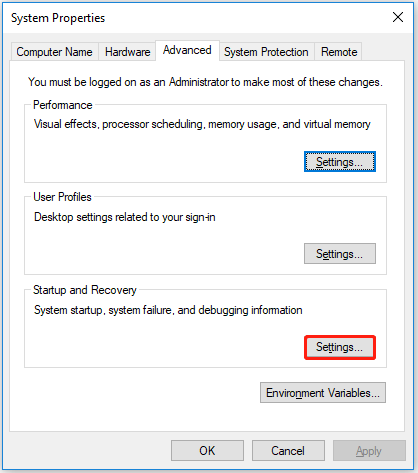
Step 3: Under the System failure section, uncheck the Automatically restart box. Then click the OK button.
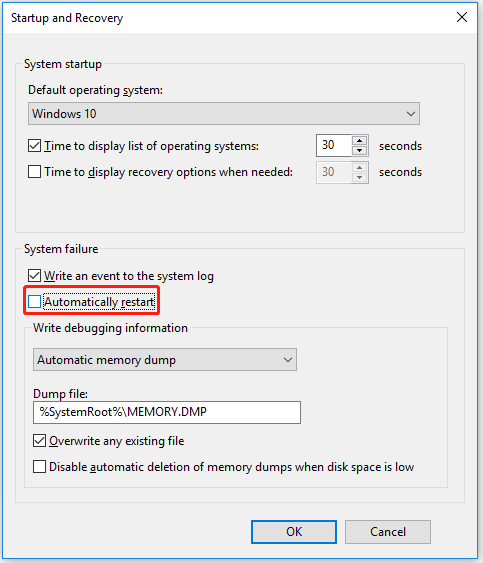
Solution 1: Perform a Windows Startup Repair
PROCESS1_INITIALIZATION_FAILED Windows 10 error caused a very serious system crash in Windows, which may affect Windows 10 startup. Therefore, the Startup Repair tool will fix the problem that restricts Windows 10 startup.
Step 1: Insert the installation media drive (such as CD/DVD/USB) into the Windows 10 computer.
Note: If you don’t have one, go to official Windows and download the media creation tool to create one.
Step 2: Restart Windows and press any key during startup.
Step 3: Choose your language preference. Then Click the Next button.
Step 4: Click Repair your computer.
Step 5: Click Troubleshoot > Advanced options > Startup Repair.
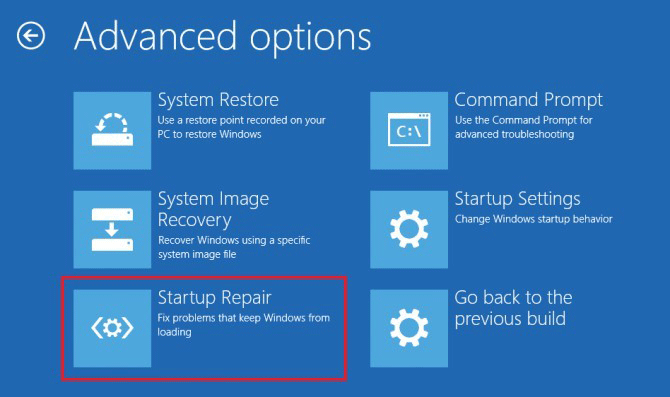
When the Startup Repair is complete, try to boot normally in Windows. If you still receive the “Process1 initialization failed” error, or if Startup Repair fails to repair your PC, please proceed to the next method.
Solution 2: Fix Disk Errors
The bad sectors or the corrupted file system in the hard disk are likely to cause the PROCESS1_INITIALIZATION_FAILED BSOD error in Windows 10.
Way 1. Run CHKDSK Utility
You can use the CHKDSK utility to investigate and repair bad sectors in the disk drive to fix this error.
Step 1: Restart your computer while press the Shift key to enter the Advanced Startup window.
Step 2: Select Troubleshoot and then Advanced Options. In the Advanced Options window, select the Command Prompt option.
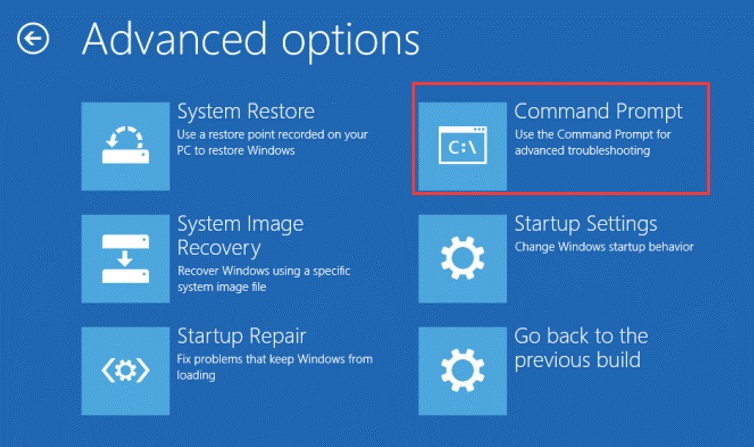
Step 3: In Command Prompt, type chkdsk C: /f /r /x command and press Enter key to execute (replace the letter of drive with that your system drive).
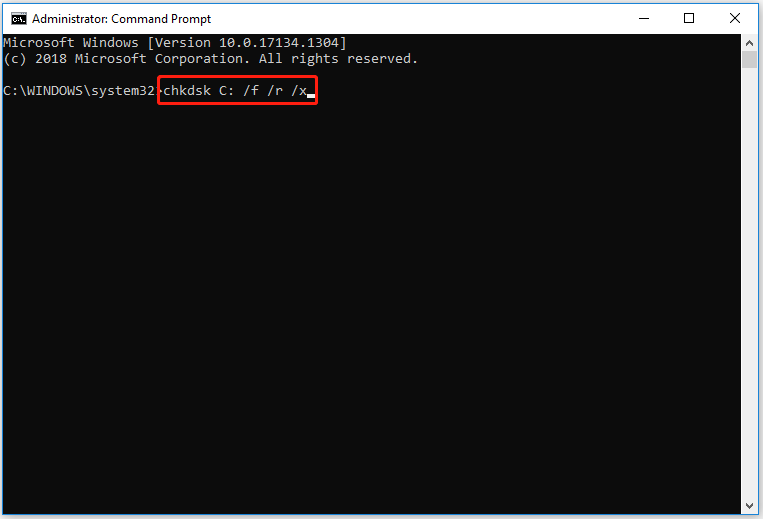
Step 4: Run chkdsk command for every partition. After execution, restart the computer and check if the error is resolved.
Way 2. Use MiniTool Partition Wizard
If the above method fails to solve the issue, you can use a professional disk management tool to check hard disk problems. It is recommended that you try MiniTool Partition Wizard. How to use MiniTool Partition Wizard to check hard disk problems? The steps are as follows.
You can use the Check File System and Surface Test feature to help you solve PROCESS1_INITIALIZATION_FAILED BSOD error.
MiniTool Partition Wizard FreeClick to Download100%Clean & Safe
Step 1: Launch MiniTool Partition Wizard to get the main interface.
Step 2: Then select the partition on the hard disk and select Check File System on the left operation panel.
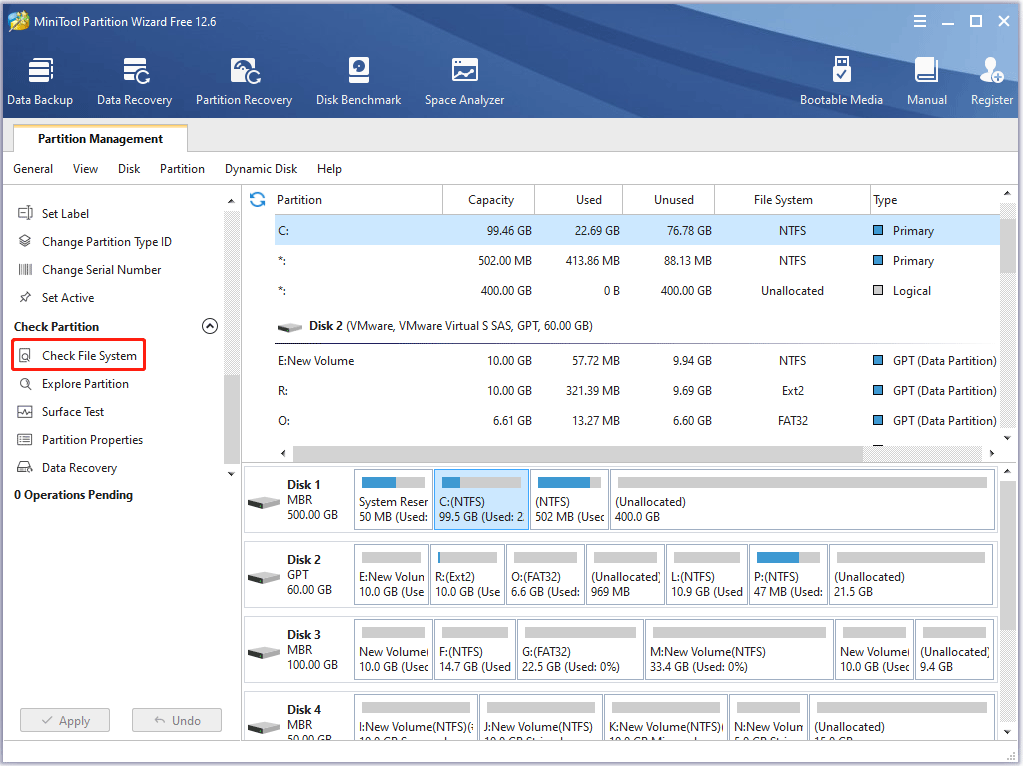
Step 3: In the pop-up window, select Check & fix detected errors and click the Start button.
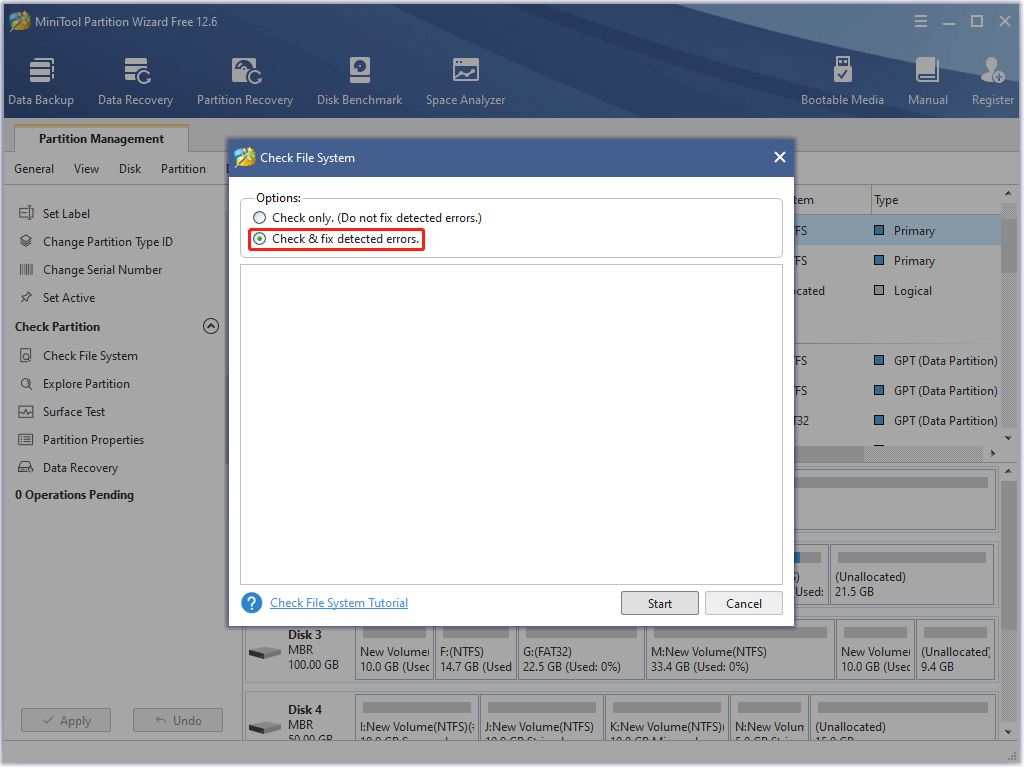
Step 4: MiniTool Partition Wizard will start scanning the file system. After the scan process completed, you can see the scanning and repairing result.
Step 5: Then select the partition on the hard disk and select Surface Test on the left operation panel.
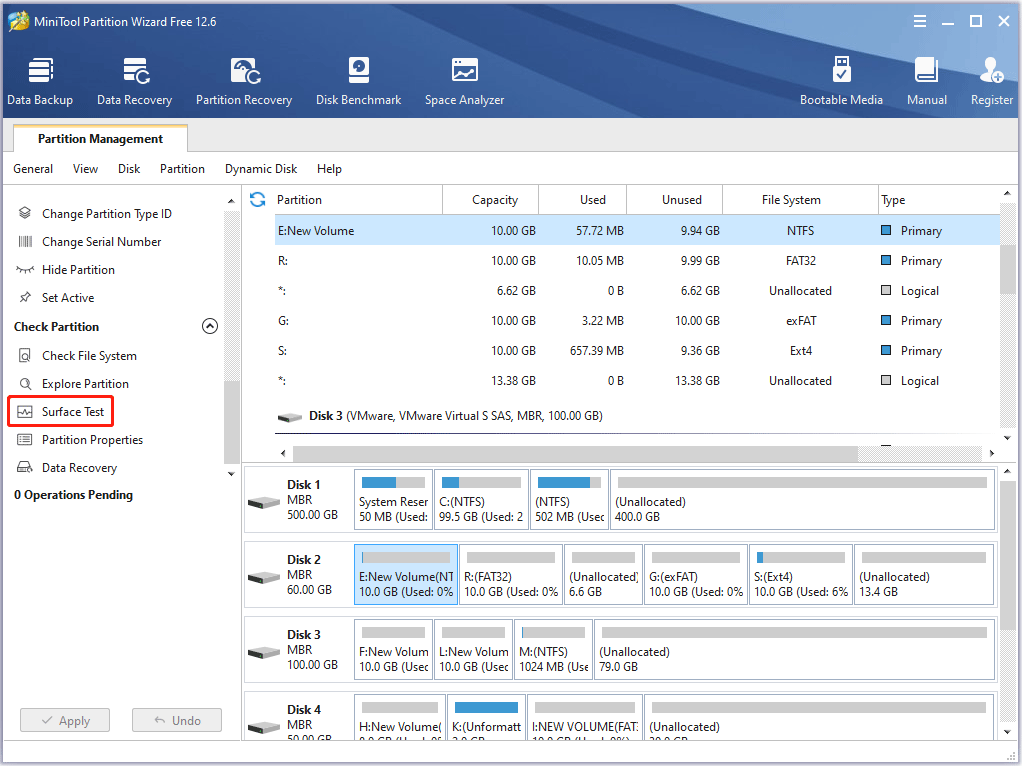
Step 6: In the pop-up window, click the Start Now button to immediately check the bad sectors for Windows 10.
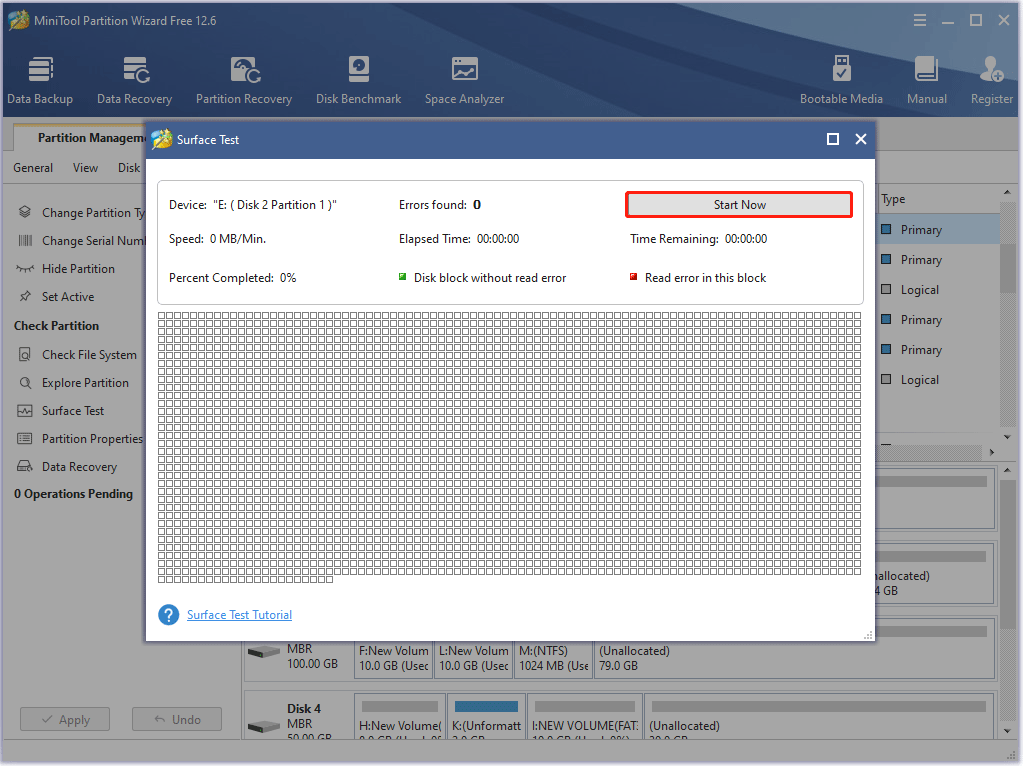
Step 7: When the hard drive error test process is completed, the disk blocks that have no read errors will be marked in green. However, if MiniTool Partition Wizard finds some hard disk errors, the blocks will be marked as red.
Note: This disk management tool detects bad physical sectors. If you find too many bad sectors on the hard drive, you need to replace the disk.
Solution 3: Delete the Bootcat.cache File
Once the Bootcat.cache file is damaged or resized at startup, Windows 10 will encounter PROCESS1_INITIALIZATION_FAILED BSOD. It is a component of CodeIntegrity, and its location in Windows is “C:WindowsSystem32Codeintegrity”. In order to solve this PROCESS1_INITIALIZATION_FAILED error, you need to delete Bootcat.cache file. Here are the steps to help you do that.
Step 1: Press the Windows + I key to open Settings, and navigate to the Update & Security > Recovery > Advanced startup option. Then click Restart now.
Step 2: When the blue screen appears, select Troubleshoot > Advanced options > Command Prompt.
Step 3: In the Command Prompt window, type the following commands in order and press Enter:
c:
cd windowssystem32codeintegrity
del bootcat.cache
After the deletion is complete, exit the command prompt and restart Windows 10.
The system will automatically recreate the Bootcat.cache file and fix the PROCESS1_INITIALIZATION_FAILED error.
Solution 4: Copy Bootcat.cache File from Another Computer
If removing the Bootcat.cache file from your computer does not resolve the PROCESS1_INITIALIZATION_FAILED blue screen error, you can copy the Bootcat.cache file from a fully functional and error-free computer running the same version of Windows 10.
Step 1: Insert USB flash drive to another computer.
Step 2: Press Windows + E key to open File Explore and navigate to following location: C:windowssystem32codeintegrity. Then right click on Bootcat.cache file and choose Copy.
Step 3: Remove the drive and insert it into the affected computer.
Step 4: Copy and paste the Bootcat.cache file to C:Windowssystem32codeintegrity.
Solution 5: Replace the NTDLL.DLL from Another Computer
The lack of some DLL files such as ntdll.dll is also the cause of the PROCESS1_INITIALIZATION_FAILED blue screen. To fix the error, you can copy the NTDLL.DLL file from the protected computer and paste it into the System32 folder of the affected computer.
Note: The process is almost similar to copying the Bootcat.cache file, but you need to register after pasting it. The prerequisite is that it is safe to use the USB drive, and the computer you want to copy from must have the same version of Windows 10.
Step 1: Insert USB flash drive to another computer.
Step 2: Go to C:WindowsSystem32 and copy all files with a .dll extension. Paste the project to the USB drive.
Step 3: Remove the drive and insert it into the affected computer.
Step 4: Copy and paste all .dll files to C:WindowsSystem32.
Step 5: Launch the Command Prompt and enter the following command:
regsvr32 (name of DLL file)
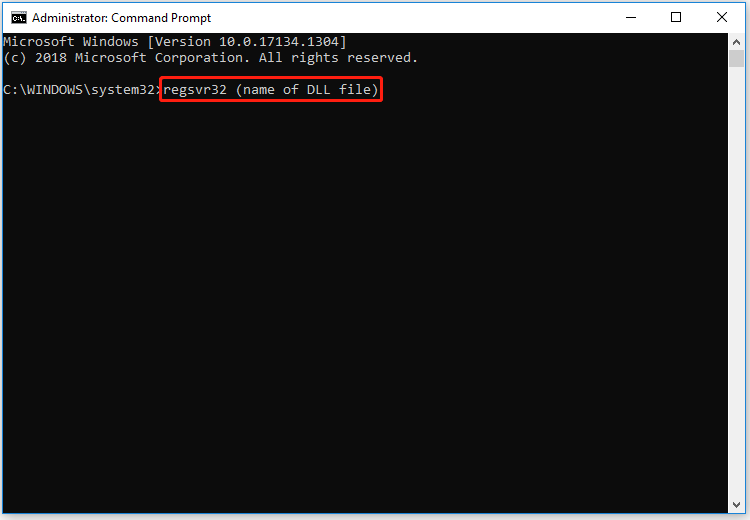
Note: Replace the DLL file names with ntdll.dll, wintrust.dll, vbscript.dll, oleaut32.dll, cryptdlg.dll, softpub.dll, jscript.dll, initpki.dll, msxml.dll in sequence. Press Enter after each.
Step 6: Reboot your computer.
Solution 6: Run System File Checker
Damaged or rewritten system files may cause the error “PROCESS1_INITIALIZATION_FAILED”. You can use System File Checker to solve these broken system files.
Step 1: Press Windows + S key and type cmd.exe in the search of the box. Then right-click it and select Run as administrator.
Step 2: In the Command Prompt window, type sfc /scannow and press Enter.
Step 3: Restart your computer.
After the image file is damaged by a third-party tool or malware attack, it will cause a blue screen or blue screen error in Windows 10. Therefore, running the DISM (Deployment Image Servicing and Management) tool is the best way to repair defective image files.
Step 1: Press the Windows key to open the Start menu.
Step 2: Click the Power icon and select the Restart option while holding down the Shift key.
Step 3: After the restart is complete, the window will boot to Automatic Repair.
Step 4: In the blue screen that appears, select Troubleshoot > Advanced Options > Command Prompt.
Step 5: In the Command Prompt, type DISM.exe /Online /Cleanup-image /Restorehealth. Then press Enter.
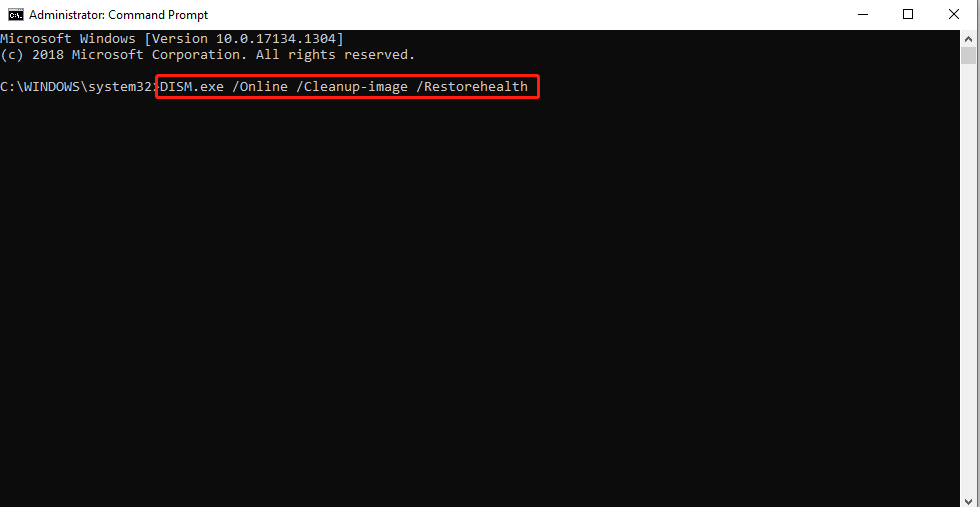
Step 6: After the DISM scan is over, restart your computer.
Solution 8: Update Drivers with Device Manager
Outdated device drivers cause PROCESS1_INITIALIZATION_FAILED errors in Windows 10. Then you can use Device Manager to update and fix them.
Step 1: Press Windows + S key and type Device Manager in the search box. Then press Enter.
Step 2: Refer to the error code you received, and check the update of the driver that caused the problem by right-clicking and selecting Update Driver.
Step 3: In a pop-up window, select Search automatically for updated driver software.
Then your Windows 10 will check, download and install the latest and appropriate driver.
Solution 9: Scan Your Entire System
You can check for malware by scanning the entire system. The steps are as follows:
Step 1: Open the Settings, and navigate to the Update & Security > Windows Security >Virus & threat protection option.
Step 2: In the Windows Defender Security Center, click the Scan now option.
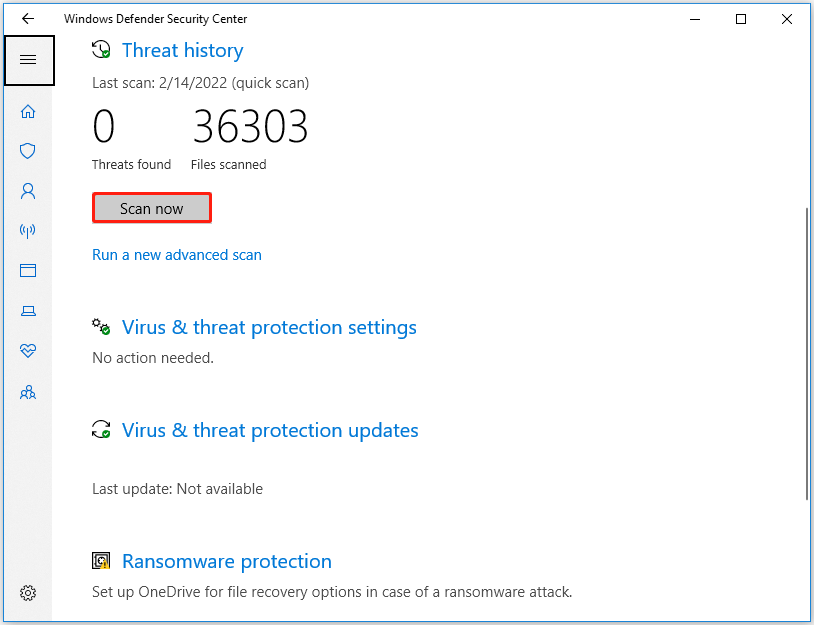
The Windows Defender Security Center will now start to detect if there are any threats on the system. After the scan is over, you will notice the results. If the scan finds any threats, click the Clean threats button to remove them from the system.
Solution 10: Run System Restore
The latest changes in Windows may contradict the Windows registry, resulting in the PROCESS1_INITIALIZATION_FAILED error. So, load back to the previous state through system restore.
Step 1: Press Windows + R key to open Run and type rstrui. Then press Enter key.
Step 2: When the System Restore window opens, click on the Next option to generate a restore of the device.
Step 3: Select the latest and click Next to continue. Finally, click Finish to let start this process.
Note: This method is based on the premise that you have proper system restore points.
Solution 11: Reinstall Windows 10
If none of these methods help you resolve the PROCESS1_INITIALIZATION_FAILED” error, please try to reinstall Windows.
Note: Before installing, please make sure that you have saved a backup and stored all your important data and files in a safe place.
Step 1: Create an installation media (DVD, CD, or USB flash drive) to install the operating system. Then insert it into the computer.
Step 2: When prompted, press any key (F2, DEL, F12) to enter BIOS. Then set the installation media as the first boot order to boot the computer.
Step 3: On the Windows Installer, click the Next button.
Step 4: Click Install now button.
Step 5: Follow the on-screen instructions to complete the setup configuration. When the installation process is completed, you just need to log in with your account.
Here are some solutions about how to fix PROCESS1_INITIALIZATION_FAILED error on Windows 10. I’d like to share them with you. These solutions are easy to operate. You can try it.Click to Tweet
Bottom Line
Now we have reached the end of this article. The above content is all about the solutions for PROCESS1_INITIALIZATION_FAILED Windows 10.
After trying so many solutions, we believe that you may have successfully solved your problem. If you have any suggestions or need any help when you use MiniTool Wizard Partition, you are welcome to send us an email at [email protected] or leave a comment below. Thank you in advance.
What is ‘Startup issue process1 initialization failed’ – BSOD error in Windows 10?
In this article, we are going to discuss on How to fix Startup issue process1 initialization failed Windows 10. You will be guided with easy steps/methods to resolve the issue. Let’s starts the discussion.
‘Startup issue process1 initialization failed’ – BSOD error in Windows 10:
‘Startup issue process1 initialization failed’ error is common Windows Problem considered as Blue Screen of Death (BSOD) error. This BSOD error is appeared with message saying ‘Your PC ran into a problem and needs to restart. We’re just collecting some error info, and then we’ll restart for you’ along with some Windows Stop Codes like ‘Process1 Initialization Failed STOP 0x0000006B’ error.
This BSOD error is usually appeared in the middle of your work on computer or when you start/restart your Windows 10/11 computer. There could be several reasons behind the issue including outdated/corrupted Windows device drivers, outdated Windows OS, corruption in system files or registry, or in system image, malware or viruses infections in computer, and other windows issues.
You should make sure all device drivers are properly installed in your computer and are up-to-date to latest & compatible version, and also make sure Windows OS is up-to-date to latest version. Updating all device drivers and Windows OS in computer can resolve this type of issue. If the issue is still persist, you can follow our instructions to fix the issue. Let’s go for the solution.
How to fix Startup issue process1 initialization failed Windows 10?
Method 1: Fix ‘Startup issue process1 initialization failed’ – BSOD error with ‘PC Repair Tool’
‘PC Repair Tool’ is easy & quick way to find and fix BSOD errors, DLL errors, EXE errors, problems with programs/applications, malware or viruses issues, system files or registry issues, and other system issues with just few clicks.
Method 2: Update Device Drivers in Windows PC
Updating all necessary device drivers to latest & compatible version can resolve the issue. You can update all Windows drivers including graphics card drivers, sound card drivers and other device drivers using Automatic Driver Update Tool. You can get this tool through button/link below.
Method 3: Update Windows 10 OS
Updating Windows OS latest version can resolve the issue.
Step 1: Open ‘Settings’ app in Windows PC via Windows Search Box and go to ‘Update & Security > Windows Update’ and click ‘Check for updates’ button
Step 2: Download and install all available updates in your computer and once updated, restart your computer and check if the issue is resolved.
Method 4: Run Blue Screen troubleshooter

Windows built-in Blue Screen troubleshooter can resolve the issue. Let’s try.
Step 1: Open ‘Settings’ app in Windows PC and go to ‘Update & Security > Troubleshoot’
Step 2: Find and click ‘Blue Screen’ troubleshooter, and click ‘Run the troubleshooter’ button and follow on-screen instructions to finish troubleshooting. Once finished, check if the issue is resolved.
Method 5: Run SFC scan, DISM scan and CHKDSK scan

You can run SFC scan, DISM scan and CHKDSK scan in computer in order to fix corruption in system files and in system image, and hard disk drive corruption.
Step 1: Type ‘cmd’ in Windows Search Box and press ‘SHIFT + ENTER’ keys on keyboard to open ‘Command Prompt as Administrator’
Step 2: Type the following commands one-by-one and hit ‘Enter’ key after each line to execute.
sfc /scannow
DISM /Online /Cleanup-Image /RestoreHealth
chkdsk /f /r C:
Step 3: Once executed, restart your computer and check if the issue is resolved.
Method 6: Delete Bootcat.cache
Step 1: Restart your computer several time until you see Windows Recovery Environment screen
Step 2: Select ‘Troubleshoot > Advanced Options > Command Prompt’ and execute the following command
C:
cd windows/system32/codeintegrity
del bootcat.cache
Step 3: Once executed, restart your computer and check if the issue is resolved.
Method 7: Disable Secure Boot
Another possible way to fix the issue is to disable Secure Boot feature in your Windows computer. You can disable Secure Boot feature through BIOS settings of your computer, and once done, check if the issue is resolved.
Method 8: Check your hardware
This issue can be occurred due to some issue with hardware like hard disk, RAM, cables, and other memory. You can download & install MemTest86+ tool in your computer in order to thoroughly test your RAM and check and fix the issue.
Method 9: Perform System Restore
If the issue is still persist, you can perform System Restore in your computer in order to fix the issue.
Step 1: Press ‘Windows + R’ keys on keyboard, type ‘rstrui’ in ‘Run’ window and hit ‘Ok’ button to open ‘System Restore’
Step 2: Click ‘Next’, select valid restore point according to date & time when there was no issue at all in computer, and then click ‘Next > Finish’ to start restoring process and once done, check if the issue is resolved.
Conclusion
I am sure this post helped you on How to fix Startup issue process1 initialization failed Windows 10 with several easy steps/methods. You can read & follow our instructions to do so. That’s all. For any suggestions or queries, please write on comment box below.
When Windows detects hardware or software problem, Windows generate error code which identifies what is happening on your computer, notebook, tablet or smartphone. One of these errors is named Blue Screen Of Death (BSOD). End users do not like BSOD because BSOD is stopping our daily work. Every BSOD includes error name and an error code which help us to identify the possible issue. One of the BSOD which will be the topic of this article is PROCESS1_INITIALIZATION_FAILED, error code 0x0000006B. What Microsoft said about error code 0x0000006B? Microsoft said: “This issue occurs because of the Bootcat.cache file is corrupted or because of the size of the Bootcat.cache file is changed since the last successful start.” We can confirm this problem with Bootcat.cache, and add another reasons including corrupted files, bad hardware, bad or incorrect cables and others. BSOD 0x0000006B occurs on operating system from Windows 2000 to Windows 10, and Windows Server 2008, too.
This is error code:
STOP: 0x0000006B (Parameter1, Parameter2, Parameter3, Parameter4)
PROCESS1_INITIALIZATION_FAILED
NOTE: The four parameters in the Stop error message may vary, depending on the configuration of the computer.
This error occurs on client and server machines, and on smartphones, too. In 16 methods we will show you how to solve issues on client and server machines, and the last one method will show you how to solve issues on your Windows Phone smartphone.

So what is the best solution for this problem? We will show you all solutions through 17 methods.
Method 1: Delete Bootcat.cache file
As Microsoft said, the first solution is to delete Bootcat.cache file from a CodeIntegrity folder, so, we will start with deleting this file from CodeIntegrity . Bootcat.cache file is a file located at following location C:\Windows\Ssystem32\Codeintegrity. By default, Windows is installed on C: partition and default name is a Local Disk (C:). We will show you how to delete Bootcat.cache file on Windows 7 Enterprise x64. If you are using another operating system, from Windows 2000 to Windows 10, you can follow the same procedure to solve issues with BSOD 0x0000006B. You will need to boot your computer to proper Windows operating system. You can boot your computer using DVD or USB flash drive. You should burn Windows ISO file to DVD or USB Flash drive. If you do not know how to burn ISO file to your USB flash drive, please read instructions on this LINK.
- Insert the Windows 7 installation DVD disk or USB flash drive
- Restart your Windows
- Boot your computer from the DVD drive or USB flash drive
- Enter your language and other preferences and click Next to continue
- Click Repair your computer
- Under System Recovery Options click Windows 7 and then click Next
- Click Command Prompt
- Type diskpart. Diskpart is a command line disk partitioning utility integrated into Windows. Diskpart will provide more information about available volumes on our computer.
- Type list volume and press Enter.
- Type Exit to leave Diskpart
- Type D: to open our system partition, because Windows is installed on D: partition
- Type cd windows\system32\codeintegrity and press Enter
- Type del bootcat.cache and press Enter
- Close Command prompt
- Restart your computer
- Test your computer
Method 2: Copy Bootcat.cache file from another computer
If the first method did not solve your problem, you should try this method, which includes copying Bootcat.cache file from another operating system which is working without any problems. If you have a problem with Windows 7 x64, you need to copy Bootcat.cache file from the same Windows, but a different computer. For this method, you will need USB flash disk with minimal capacity because Bootcat.cache is approximately 5 MB. Also, you will need Windows 7 x64 installation disk, which can be burned to DVD or USB flash disk. We will show you how to copy Bootcat.cache on Windows 7 x64. The first step is copying Bootcat.cache file to USB flash drive, and second step is to paste copied Bootcat.cache file to CodeIntegrity folder.
- Log on another machine
- Insert USB flash drive to working computer
- Hold Windows logo and press E to open Windows Explorer or File Explorer
- Navigate to following location C:\Windows\System32\Codeintegrity
- Right click on Bootcat.cache file and choose Copy
- Open your USB flash disk
- Right click and select Paste
- Eject USB flash drive from machine
- Insert USB flash drive into machine with BSOD issue
- Insert the Windows 7 installation DVD disk or USB flash disk
- Restart your Windows
- Boot your computer from the DVD drive or USB flash disk
- Enter your language and other preferences and click Next to continue
- Click Repair your computer
- Under System Recovery Options click Windows 7 and then click Next
- Click Command Prompt
- Type diskpart. Diskpart is a command line disk partitioning utility integrated into Windows. Diskpart will provide more information about available volumes on our computer.
- Type list volume and press Enter.
- Type Exit to leave Diskpart
- Type D: to open our system partition, because Windows is installed on D: partition
- Type cd windows\system32\codeintegrity and press Enter
- Type copy E:\bootcat.cache and press Enter, because E: is USB flash disk
- Close Command prompt
- Restart your computer
- Test your computer
Method 3: Copy ntdll.dll file from another computer
If the first two methods did not solve your problem, you will need to copy another file, named ntdll.dll, from one to another machine. If you have a problem with Windows 10 x64, you should copy ntdll.dll from the computer which uses the same operating system edition. Again, we will show you how to do it on Windows 7 x64. The procedure is simple as copying Bootcat.cache file. Regardless, we will show you the whole procedure. For this method, you will need USB flash disk with minimal capacity because ntdll.dll is approximately 1.6 MB. Also, you will need Windows 7 x64 installation disk, which can be burned to DVD or USB flash disk. We will show you how to copy ntdll.dll on Windows 7 x64. The first step is copying ntdll.dll file to USB flash drive, and second step is to paste copied ntdll.dll file to a System32 folder.
- Log on another machine
- Insert USB flash drive to working computer
- Hold Windows logo and press E to open Windows Explorer or File Explorer
- Navigate to following location C:\Windows\System32
- Right click on ntdll.dll file and choose Copy
- Open your USB flash disk
- Right click and select Paste
- Eject USB flash drive from machine
- Insert USB flash drive into machine with BSOD issues
- Insert the Windows 7 installation DVD disk or USB flash disk
- Restart your Windows
- Boot your computer from the DVD drive or USB flash disk
- Enter your language and other preferences and click Next to continue
- Click Repair your computer
- Under System Recovery Options click Windows 7 and then click Next
- Click Command Prompt
-
Type diskpart. Diskpart is a command line disk partitioning utility integrated into Windows. Diskpart will provide more information about available volumes on our computer.
- Type list volume and press Enter.
- Type Exit to leave Diskpart
- Type D: to open our system partition, because Windows is installed on D: partition
- Type cd windows\system32 and press Enter
- Type copy E:\ntdll.dll and press Enter, because E: is USB flash disk
- Close Command prompt
- Restart your computer
- Test your computer
Method 4: Delete file COMPONENTS
If deleting and copying Bootcat.cache and ntdll.dll did not solve your problem, next method will include working with file named COMPONENTS. You need to delete file COMPONENTS through Command Prompt. We will show you how to do it on Windows 7 x64. You will need Windows 7 x64 installation disk, which can be burned to DVD or USB flash disk.
- Insert the Windows 7 installation DVD disk or USB flash disk
- Restart your Windows
- Boot your computer from the DVD drive or USB flash disk
- Enter your language and other preferences and click Next to continue
- Click Repair your computer
- Under System Recovery Options click Windows 7 and then click Next
- Click Command Prompt
- Type diskpart. Diskpart is a command line disk partitioning utility integrated in Diskpart will provide more information about available volumes on our computer.
- Type list volume and press Enter.
- Type Exit to leave Diskpart
- Type D: to open our system partition, because Windows is installed on D: partition
- Type cd windows\system32\config and press Enter
- Type del components and press Enter
- Close Command prompt
- Restart your computer
- Test your computer
Method 5: Install Windows 7 SP1
If you are using Windows 7 without SP1, you will need to download SP1 for your Windows 7. If you are using Windows 7 x86, you will need to download and install Windows 7 SP1 x86, if you are using Windows 7 x64, you will need to download and install Windows 7 SP1 x64. Windows 7 SP1 is available on Microsoft Download Center.
- Open Internet browser (Google Chrome, Mozilla Firefox, Edge or other)
- Open web site on this LINK
- Download proper architecture version of Windows 7 SP1
- Install Windows 7 SP1
- Restart your Windows
- Test your computer
Method 6: Uninstall Roxio GoBack
If you are using Roxio GoBack software, you will need to uninstall software and enjoy working on your computer, without boring BSOD error. So, what is Roxio? Roxio GoBack is disk utility developed by Norton which provides recording up to 8 GB of disk changes. If you are not using Roxio GoBack software, then you need to read another method. We will show you how to remove Roxio GoBack software from your computer. We are using Windows 7 x64 and Roxio GoBack Deluxe Edition.
- Hold Windows logo and press R
- Type appwiz.cpl and press Enter
- Select Roxio GoBack Deluxe Edition software
- Right click on Roxio GoBack Deluxe Edition software and choose Uninstall
- Follow the procedure to uninstall Roxio GoBack Deluxe Edition software
- Restart your Windows
- Test your computer
Method 7: Repair a Windows Image using DISM
For this method, we will need to use a tool named DISM (Deployment Image Servicing and Management). The DISM is command line tool which allows you to mount Windows image file (install.wim) and do image servicing including installing, uninstalling, configuring and Windows update. DISM is a part of Windows ADK (Windows Assessment and Deployment Kit) which you can download on this LINK. The procedure of repairing Windows image is the same for operating systems Windows 7 to Windows 10.
- Open Internet browser (Google Chrome, Mozilla Firefox, Edge or other)
- Open website on this LINK to download Windows ADK
- Run Windows ADK
- Choose DISM (Deployment Image Servicing and Management) and click Install
- Click Start menu and type Deployment Image Servicing and Management
- Right click on Deployment Image Servicing and Management and choose Run as Administrator
- Click Yes to accept running DISM as Administrator
- Type DISM /image:D:\ /cleanup-image /revertpendingactions and press Enter
- Restart your Windows
- Test your computer
Method 8: Exclude a folder from scans
The cause of the BSOD problem can be Antivirus, too. To alleviate the problems, you should exclude CodeIntegrity and catroot folders from antivirus scanning. We will show you how to exclude both folders on Windows Defender which is by default integrated into Windows 10. If you are using another antivirus, you should exclude CodeIntegrity and catroot from the scan. If you do not have experience with configuration of antiviruses, please read user manual of antivirus you are using. Terminology is the same, only user experience could be different.
- Click on Start menu and type Windows Defender
- Right click on Windows Defender and choose Run as Administrator
- Click Yes to confirm running Windows Defender as Administrator
- Click Settings at the top right corner
- Click Add and exclusion under Exclusions
- Click Exclude a folder
- Navigate to folder CodeIntegrity on following location C:\Windows\System32\CodeIntegrity
- Click Exclude this folder
- Click Exclude a folder, again
- Navigate to folder catroot on following location C:\Windows\System32\catroot
- Click Exclude this folder
- Check are folders added well
- Test your computer
Method 9: Remove malware
You should be careful when you are browsing the Internet. There are a lot of malware which will try to attack your computer, destroy your operating system, application or your data. BSOD occurs because malware infects your computer and make some damage. The first step you should do is scan your hard disk with Antivirus. If you are home users, you can download freeware antivirus including Avira, Avast, AVG, and others. In case you are using Windows 8 and Window 10, you can use Windows Defender, which is integrated into your operating system. After you remove all malware, you need to restart your Windows. If malware infected some files and your antivirus can not remove malware from file, files will be moved to quarantine or delete from your hard disk. If malware infects Bootcat.cache or ntdll.dll, you should remove that files and copy the same files from another computer. How you will do it? Please read first four methods. To be more secure, we are recommending you to update your operating system, applications and drivers.
Method 10: Restore your operating system from backup
A lot of users are ignoring doing a backup and restore. One of the most important steps in business, and in your home environment is to implement backup and restore strategies. There are few backup tasks you can do including creating a system image, turning on system restore and backup of your data. In the case of failure, you can revert your operating system to the previous state when everything worked without any problems. Few users solved problem with BSOD by doing system image restore.
Method 11: System restore
Sometimes after Windows update or some system changes, computer stops to work. The solution for this to revert your Windows to the previous state, before that update or system changes. One of the steps end users are ignoring is creating a system restore checkpoints. If you are not one of the users who ignored this, we are recommending you to restore your Windows to the previous state using System Restore. If you know when computer worked without problems, revert your Windows to that date. If System Restore is not enabled on your computer, then you need to read Method 9. We are recommending you to enable System Restore, by reading this LINK.
- Hold Windows logo and press Enter
- Type rstrui.exe and press Enter
- Click Choose a different restore point and click Next
- Choose proper checkpoint and click Next
- Click Finish
- Restart your Windows and wait until Windows finished system restore
- Test your computer
Method 12: Disconnect UPS devices
Microsoft said: “If you have an uninterruptible power supply (UPS) connected to your destination computer, disconnect the serial cable before installing the Service Pack. Setup automatically attempts to detect devices that are connected to serial ports, and UPS equipment can cause issues with the detection process. You can leave your computer connected to a UPS for power as long as the UPS itself is plugged in. However, you should make sure that you have enough power for the entire installation, which can take a long time.”
Based on that we are recommending you to disconnect UPS device from your server machine or client machines, install SP1 (method 5) and eliminate BSOD issue. Few users solved issue on their server by using this method.
Method 13: Change CD or DVD
Sometimes, you can not install an operating system from CD or DVD, because you are using scratched CD or DVD. We are recommending you to burn another CD or DVD, or to burn operating system to USB flash drive. If this did not solve the problem, next step is to change cables and CD or DVD disk. If you are using ATA drive (old computers) you should buy ATA CD or DVD drive, and if you are using SATA drive, you should buy SATA CD or DVD drive. Please note that you can not install ATA CD or DVD drive to SATA port, and vice versa.
Method 14: CHKDSK /R
When your HDD is not working good because of file corruption or bad sectors, you should do a check disk. Check disk is a utility which will help you to find bad sectors, and fix them in case there are fixable. You will do it through Command prompt.
- Click on Start menu and type Command prompt
- Right click on Command prompt and choose Run as Administration
- Click Yes to confirm running Command prompt as Administrator
- Type chdksk /r and press Enter. Because you want to check system partition you will need to restart your computer.
- Type Y and press Enter to accept resetting your computer
- Restart your Windows
- Please wait until Windows finished repairing file system on computer. There are 5 stages which should be finished.
- Test your computer
Method 15. Change HDD or SSD
When there is no problem with software, next step will be changing hardware components. HDDs are SSDs are storing our operating systems, drivers, application, and data. When software troubleshooting is not giving a good result, next step should be changing hardware components. You will need to change your HDD or SSD. Be careful when purchasing HDD. There are two different types of HDDs, ATA and SATA. You can not install SATA HDD to ATA port, and vice versa. Also, there are different SATA standards, including SATA I, SATA II, SATA III and SATA 3.1. Different standards provide different transfer rates. If you are using motherboard which supports only SATA I, you do not need to buy HDD SATA III, because HDD SATA III will work as SATA I HDD, because of port limitation. All SSDs are using SATA connectors. Some of HDD’s and SSD’s manufacturer are WD, Seagate, Samsung, Kingston, Adata, and others.
Method 16: Change RAM module
Sometimes because of faulty RAM, Windows’s or application’s instructions can not be stored in RAM address pool, and because of that, you will see BSOD on your monitor. Few users solved their problem by changing RAM module. How will you do it? If you are using more RAM modules, you should try to unplug one by one and test is there a problem with RAM module. Also, if you are planning to purchase another RAM module, you should check which generation of RAM memory is using your motherboard. As always, we are recommending you to check the technical documentation of your motherboard and based on that you can purchase proper RAM module for your computer or notebook. We will show you how to check which RAM module is using notebook HP 2000-2b09WM.
- Open Internet browser (Google Chrome, Mozilla Firefox, Edge or other)
- Open HP’s website on this LINK. We will open HP Support site because we are using HP notebook
- Navigate to Memory section. In our example. HP 2000 is using DDR3 RAM, and there are 2 memory slots available, for maximum 8 GB RAM.
- Purchase RAM module
- Install RAM module
- Test your computer
SOLUTION FOR SMARTPHONES
Method 1: Reset Windows Phone
If you are using Windows Phone, you can see PROCESS1 INITIALIZATION FAILED. It is not weird, because Windows Phone is using Windows 8, Windows 8.1 or Windows 10 operating system. You tried to update your Windows Phone, and update process stopped because of BSOD. What should you do?
- Shutdown your phone
- Hold Volume down and Power button
- Finish updating your smartphone

























